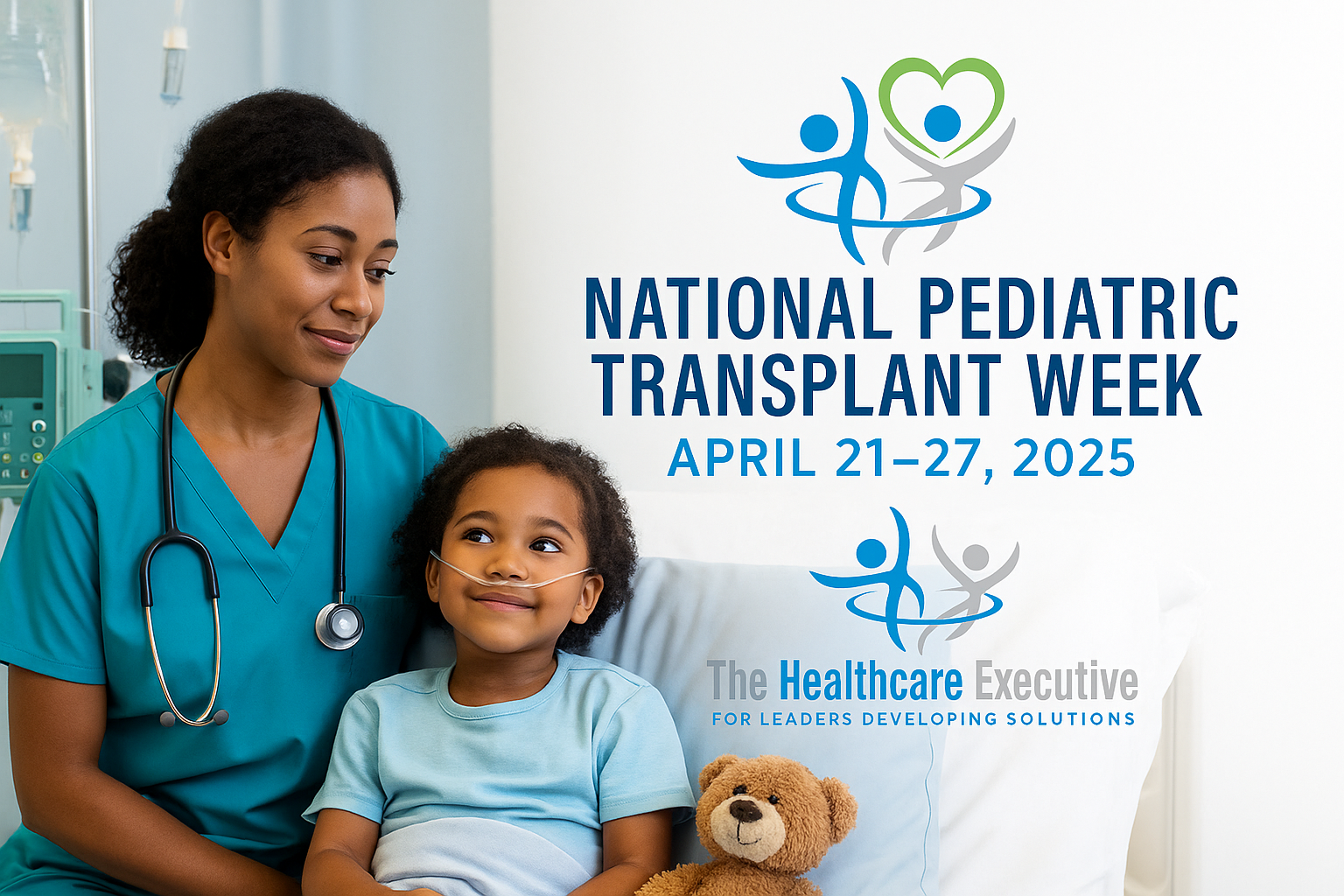National Pediatric Transplant Week

- Posted by Greg Wahlstrom, MBA, HCM
- Posted in Health Observance Calendar
Executive Leadership for Lifesaving Pediatric Transplants
Published: April 21, 2025
National Pediatric Transplant Week shines a vital spotlight on the stories, science, and systems that save young lives through organ donation. This observance, recognized during the last full week of April, honors both the children who have received transplants and the families who have made donations possible. According to the U.S. Department of Health and Human Services, over 1,900 children under 18 are currently on the transplant waiting list. Pediatric patients require specialized protocols, urgent prioritization, and long-term care planning—challenges that demand executive-level leadership and system-wide collaboration. From boardroom decisions to bedside care, hospital executives have the power to shape transplant outcomes through resource allocation, cross-institutional partnerships, and policy integration. Highlighting this week helps healthcare leaders educate communities about pediatric transplantation’s unique needs and opportunities. Health systems can also use this observance to celebrate clinical achievements, donor recognition programs, and breakthrough innovations in pediatric transplant medicine. It’s a critical time to highlight how care teams, patients, and administrators work together to transform lives. Strategic leadership is key to translating this awareness into action.
Hospital executives have a unique responsibility to support and scale pediatric transplant programs through infrastructure, innovation, and integration. These lifesaving procedures require specialized ICU capabilities, transplant surgeon coverage, and pediatric support teams—all of which must be backed by funding and strategic alignment. At institutions like Cincinnati Children’s Hospital Medical Center, pediatric transplant centers are built on multidisciplinary collaboration and executive sponsorship. To achieve similar outcomes, health systems must focus on optimizing pediatric organ allocation policies, transplant care models, and patient family navigation services. Administrators should ensure that patient experience frameworks include culturally competent support for families navigating transplant evaluations. Communication across pediatric, surgical, pharmacy, and palliative care units should be standardized for continuity of care. National Pediatric Transplant Week is also an opportunity to brief board members on transplant volumes, waitlist trends, and performance benchmarks. Hospital CMOs and COOs should coordinate with pediatric transplant teams to identify workflow gaps, reduce care variation, and expand access. Leaders who prioritize transplant readiness planning will be best positioned for long-term program growth. Through strategic oversight and clinical alignment, executives turn observance weeks into year-round value.
Equity must remain central to all pediatric transplant initiatives, as disparities in organ allocation and post-transplant care continue to affect outcomes. Research published in Pediatrics shows that children from underserved and minority populations are less likely to receive timely transplants and more likely to face complications. Hospital boards must prioritize partnerships with national and community-based organizations that promote equity in organ donation and transplant access. One standout model is the collaboration between Children’s Hospital Los Angeles and community clinics, which delivers multilingual transplant education, case management, and transportation services for families. Equity strategies should be embedded in strategic plans and DEI dashboards, with specific metrics tracking outreach effectiveness, representation, and transplant equity. Executives can also work with school districts, faith-based leaders, and local health departments to expand awareness beyond clinical settings. System-wide education must be reinforced by operational policy, reimbursement advocacy, and philanthropic support to scale what works. Trust-building starts with culturally competent leadership and ends with equitable access to care. National Pediatric Transplant Week provides the perfect platform to launch or reinforce those commitments.
Beyond hospital walls, this observance week opens the door for regional collaboration across donor networks, payers, and academic medical centers. Transplant outcomes improve when health systems coordinate efforts, pool resources, and share data-driven practices. National Pediatric Transplant Week is an ideal time for executive leaders to engage with their regional Organ Procurement Organizations (OPOs) and pediatric transplant coalitions. Initiatives such as shared pediatric donor pools, cross-system telehealth evaluations, and interfacility transport protocols must be championed by C-suite decision-makers. Success depends not just on internal readiness, but on strategic alliances that accelerate access and safety. At Texas Children’s Hospital, leaders work closely with national and international partners to coordinate complex transplant logistics. Hospital executives elsewhere can replicate this approach by designating pediatric transplant liaisons, hosting awareness summits, and investing in interoperability platforms. Real collaboration transforms pediatric transplant delivery from fragmented to integrated. National observance weeks help galvanize executive buy-in for these long-term regional strategies.
As National Pediatric Transplant Week progresses, healthcare leaders have a unique opportunity to align mission, margin, and meaning. The week should serve as more than symbolic awareness—it should be a springboard for system-wide reflection, renewal, and readiness. Hospital communications teams can amplify stories of pediatric survivors, donor families, and clinicians through video campaigns and digital storytelling. Board briefings should summarize transplant activity, policy updates, and funding needs to advance institutional excellence in this domain. Administrators can also encourage internal recognition programs, spotlighting pediatric transplant nurses, social workers, and surgeons. Patient-family advisory councils should be invited to share insights on how health systems can improve care before, during, and after transplant. Operational goals can include reducing time-to-listing, expanding post-discharge follow-up, and improving transplant access across geographic and socioeconomic lines. By acting with purpose during this week, executives send a clear signal that pediatric transplants are a leadership priority. Great outcomes require great governance. And it begins with a commitment to saving lives—one child, one system, and one future at a time.
Discover More
Learn how pediatric innovation and health equity intersect through real hospital leadership strategies.



